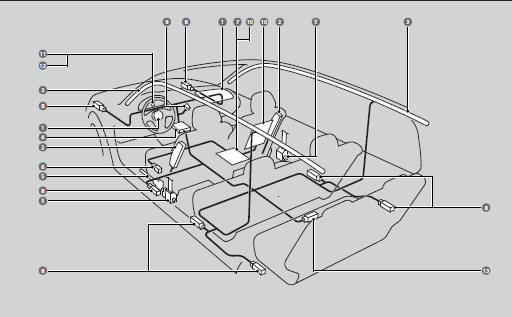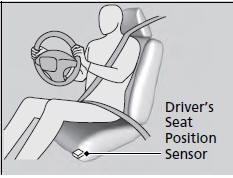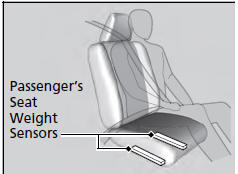Honda Odyssey Owners Manual: Airbags
Airbag System Components
The front, front side, and side curtain airbags are deployed according to the direction and severity of impact. The airbag system includes: 1 Two SRS (Supplemental Restraint System)
front airbags. The driver's airbag is stored
in the center of the steering wheel; the
front passenger's airbag is stored in the
dashboard. Both are marked SRS
AIRBAG.
Both are marked SIDE AIRBAG.
The front and rear pillars are marked
SIDE CURTAIN AIRBAG.
9 An indicator on the dashboard that alerts
you that the front passenger's front
airbag has been turned off. ■Important facts about your airbags Airbags can pose serious hazards. To do their job, airbags must inflate with tremendous force. So, while airbags help save lives, they can cause burns, bruises, and other minor injuries, and sometimes even fatal ones if occupants are not wearing their seat belts properly and sitting correctly. What you should do: Always wear your seat belt properly, and sit upright and as far back from the steering wheel as possible while allowing full control of the vehicle. A front passenger should move their seat as far back from the dashboard as possible. Remember, however, that no safety system can prevent all injuries or deaths that can occur in a severe crash, even when seat belts are properly worn and the airbags deploy. Do not place hard or sharp objects between yourself and a front airbag. Carrying hard or sharp objects on your lap, or driving with a pipe or other sharp object in your mouth, can result in injuries if your front airbag inflates. Do not attach or place objects on the front airbag covers. Objects on the covers marked SRS AIRBAG could interfere with the proper operation of the airbags or be propelled inside the vehicle and hurt someone if the airbags inflate. Do not attempt to deactivate your airbags. Together, airbags and seat belts provide the best protection. When driving, keep hands and arms out of the deployment path of the front airbag by holding each side of the steering wheel. Do not cross an arm over the airbag cover. Types of Airbags Your vehicle is equipped with three types of airbags: Each is discussed in the following pages. The airbags can inflate whenever the ignition switch
is in ON Front Airbags (SRS) The front SRS airbags inflate in a moderate to severe frontal collision to help protect the head and chest of the driver and/or front passenger. SRS (Supplemental Restraint System) indicates that the airbags are designed to supplement seat belts, not replace them. Seat belts are the occupant's primary restraint system. Dual-Stage, Multiple-Threshold Front Airbags
(SRS) During a frontal crash severe enough to cause one or both front airbags to deploy, the airbags can inflate at different rates, depending on the severity of the crash, whether or not the seat belts are latched, and/ or other factors. Frontal airbags are designed to supplement the seat belts to help reduce the likelihood of head and chest injuries in frontal crashes. Housing LocationsThe front airbags are housed in the center of the steering wheel for the driver, and in the dashboard for the front passenger. Both airbags are marked SRS AIRBAG. Operation Front airbags are designed to inflate during moderate-to-severe frontal collisions. When the vehicle decelerates suddenly, the sensors send information to the control unit which signals one or both front airbags to inflate. A frontal collision can be either head-on or angled between two vehicles, or when a vehicle crashes into a stationary object, such as a concrete wall. How the Front Airbags WorkWhile your seat belt restrains your torso, the front airbag provides supplemental protection for your head and chest. The front airbags deflate immediately so that they won't interfere with the driver's visibility or the ability to steer or operate other controls. The total time for inflation and deflation is so fast that most occupants are not aware that the airbags deployed until they see them lying in front of them. After a front airbag inflates in a crash, you may see what looks like smoke. This is actually powder from the airbag's surface. Although the powder is not harmful, people with respiratory problems may experience some temporary discomfort. If this occurs, get out of the vehicle as soon as it is safe to do so. Although the driver's and front passenger's airbags normally inflate within a split second of each other, it is possible for only one airbag to deploy. This can happen if the severity of a collision is at the margin, or threshold, that determines whether or not the airbags will deploy. In such cases, the seat belt will provide sufficient protection, and the supplemental protection offered by the airbag would be minimal. ■ When front airbags should not deploy
Side impacts: Front airbags can provide protection when a sudden
deceleration
causes a driver or front passenger to move towards the front of the vehicle.
Side
airbags and side curtain airbags have been specifically designed to help reduce
the
severity of injuries that can occur during a moderate-to-severe side impact
which
can cause the driver or passenger to move towards the side of the vehicle.
■ When front airbags deploy with little or no visible damage Examples include running into a curb, the edge of a hole, or other low fixed object that causes a sudden deceleration in the vehicle chassis. Since the impact is underneath the vehicle, damage may not be readily apparent.
■ When front airbags may not deploy, even though exterior damage
appears severe Advanced AirbagsYour front airbags have advanced features to help reduce the likelihood of airbag related injuries to smaller occupants.
The driver's advanced front airbag system includes a seat position sensor. If the seat is too far forward, the airbag inflates with less force, regardless of the severity of the impact.
The passenger's advanced front airbag system has weight sensors. Although Honda recommends against carrying an infant or small child in front, if the sensors detect the weight of a child (up to about 65 lbs or 29 kg), the system will automatically turn off the passenger's front airbag. If there is a problem with the driver's seat position sensor, the SRS indicator will come on and the airbag will inflate with full (normal) force, regardless of the driver's seating position.
For both advanced front airbags to work properly: Make sure the floor mat behind the front passenger’s seat is hooked to the floor mat anchor. An improperly placed mat can interfere with the advanced airbag sensors. |
See More:
Honda Odyssey Owners Manual > Maintenance: Checking and Maintaining Tires
Checking Tires To safely operate your vehicle, your tires must be of the proper type and size, in good condition with adequate tread, and properly inflated. ■ Inflation guidelines Properly inflated tires provide the best combination of handling, tread life, and comfort. Refer to the driver’s ...
Honda Odyssey Owners Manual
- Quick Reference Guide
- Safe Driving
- Instrument Panel
- Controls
- Features
- Driving
- Maintenance
- Handling the Unexpected
- Information


 .
.


